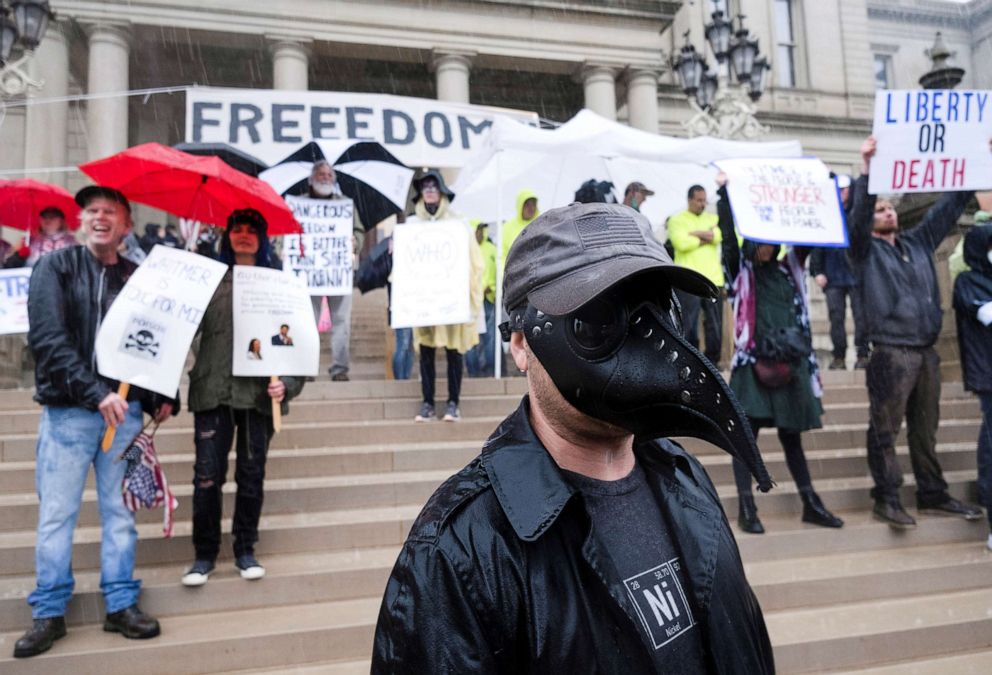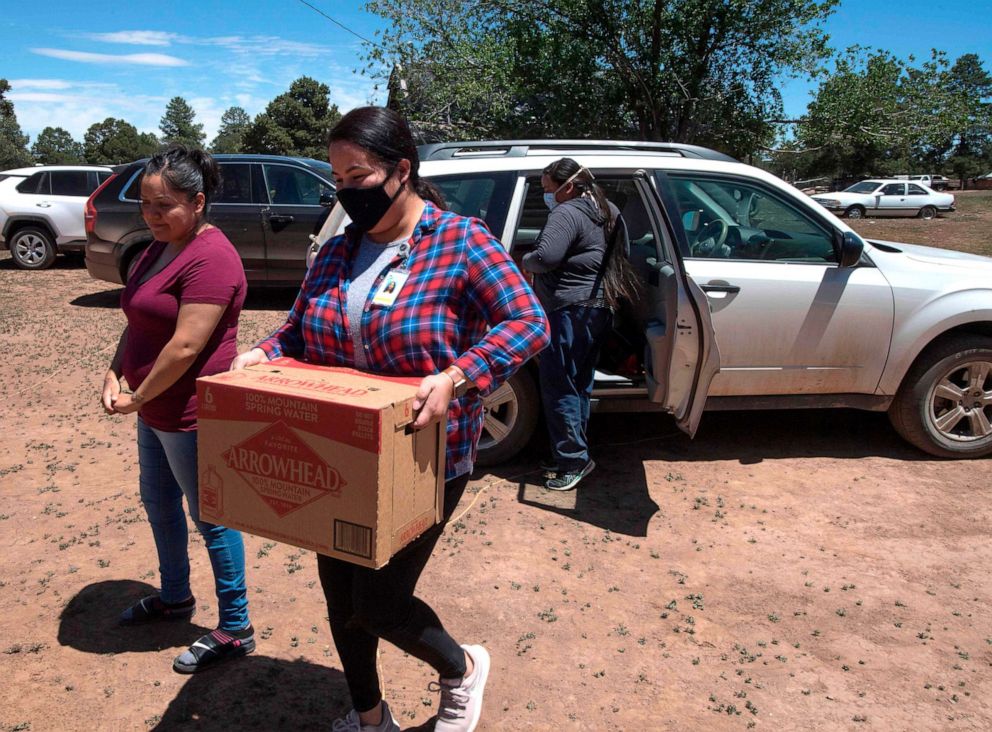Some people of color worry reopening rethreads nation's dark economic narrative: Analysis
When Harlem renaissance poet Langston Hughes wrote "I, too," he was seemingly prescient in penning a poem for a pandemic.
I, too, sing America.I am the darker brother.They send me to eat in the kitchen.When company comes,But I laugh,And eat well,And grow strong.(Excerpt from Langton Hughes' poem "I, too")
The '20s-era lyrical exploration of marginalization declaring "I, too, sing America," of being "the darker brother" sent to the kitchen, growing strong there, waiting for a day when the nation recognizes his worth sums up the experiences of people of color who disproportionately make up the invisible army of workers -- all now deemed "essential" to help the nation reopen.
When viewed through a prism of historic inequity, broken government promises and the perspective of what appears to be an apparent willingness to sacrifice black and brown lives all for the sake of patriotic progress -- communities of color worry that efforts to reopen come at a deadly price.

"We’re opening too soon at the expense of poor and low-income working people, and at the expense of the American public. This false choice, that you have to either open up, or go to work and possibly die, is a choice, it didn’t have to be this way,” Reverend Dr. William Barber, co-chairman of The Poor People’s Campaign told ABC Nightline co-anchor Byron Pitts during the network’s recent series "Pandemic: A Nation Divided" speaking broadly of reopening's impact on low-income essential workers of all races.
Many poor and low income white essential workers are facing similar stark choices about risking their lives to work amid the pandemic.
But, for the phalanx of white protesters, some of them wielding guns, who stormed Michigan’s statehouse earlier this month demanding the state’s stay-at-home order be lifted --their actions signaled a nation ready to move on from a months-long lockdown, a return to broader "civil liberties" and an “American way of life,” political and cultural analysts say.
Some saw the protests as a modern-day embodiment of Patrick Henry’s rallying cry, "Give me liberty or give me death."
The protesters' cause célèbre is lauded from the Oval Office by a president who last month tweeted "LIBERATE" as part of a series of missives directed at Democratic-led states and aimed at underscoring the belief that the shutdown’s economic impact is more perilous to the Republic than the disease itself.

To be sure, nearly two-thirds of Americans said they more closely align with the view that opening the county now is not advantageous since it will result in a higher death toll. Meanwhile, slightly more than one-third agree with the belief that an immediate reopening is beneficial to minimize the negative impact on the economy, according to an ABC News/Ipsos released earlier this month and ahead of the recent and broader swath of state reopenings.
However, those quintessentially American freedoms --the idea of being able to move unfettered by government regulations, to purchase whatever one can afford, whenever one wishes and the idea that, if one just works hard enough, the American dream is there for the taking -- are all being upended by a global pandemic, political and cultural experts point out. Those views are set to directly collide with the experience of people who’ve long felt their lives expendable for the nation.
Whether its the hard-hit Navajo Nation in the country's southwest region or similarly devastated communities in the Bronx or frustrated protesters in Michigan longing for a return to pre-pandemic freedoms, the reactions to reopening are widely different depending on one's racial and cultural history in this country.
"For a minute there, it looked like we were all in this together. And then we weren't," Derrick Johnson president and CEO of the NAACP wrote in a recent op-ed for CNN. "Data emerged that, for the first time, specified infection and death rates by race -- and the face of the pandemic changed," Johnson wrote. "It became black. And the fragile sense of social solidarity that was keeping millions of Americans at home to protect themselves and each other began to crumble. Call it 'white flight.'"
Amid the push to reopen, attitudes about contracting the coronavirus, track along stark racial and party lines, according to a new ABC News/Ipsos poll released last week. Some 87% of black Americans and 85% of Latinos polled said they are more concerned about getting the virus compared to 73% of whites.
And slightly more than half of blacks, 51%, and Latinos, 52%, said they are very concerned about the threat compared to 27% of whites.
Black and Latino Americans are also nearly three times as likely to personally know someone who has died from the virus than white Americans, according to the poll.
“We can't pretend race isn't correlating with this when people show up in Michigan with Confederate flags,” said Andra Gillespie, an associate professor of political science and the director of the James Weldon Institute for the Study of Race and Difference at Emory University.
At the core of this schism on reopening are widely divergent views on how wealth is produced and who is doing the producing, experts say.
"The way wealth was accumulated in this country involved the exploitation of people. Slavery. Low wage jobs by immigrants," said Ed Morales, an adjunct professor at Columbia University’s Center for the Study of Ethnicity and Race and author of "Fantasy Island: Colonialism, Exploitation, and the Betrayal of Puerto Rico." "The bargain that was made during Reconstruction, of not having to do that work was folded into the idea of American freedom."
There is and has always been "a lot of displacement of social responsibility that allows us to indulge in the idea of American freedom," Morales said adding that, in this country, whiteness has long been seen as a guarantee, an assurance of not being "on the wrong end of the productivity cycle," Morales said.
Experts point to research that has shown that historically, even during economic downturns and financial upheaval, white Americans tend to fare better than blacks, Latinos, Asian Americans and Native Americans.

Recent figures on the virus' impact further highlight the divide and, by extension, some of the reasons why communities of color are especially concerned.
Overall, the American economy lost 20.5 million jobs, skyrocketing the unemployment rate to 14.7%.
Broken down by racial groups, the U.S. unemployment rate in April climbed to 14.2% for whites, 16.7% for blacks, 14.5% for Asians and 18.9% for Hispanics, according to the U.S. Bureau of Labor Statistics.
While white Americans make up the majority of essential workers nationally, people of color are heavily overrepresented, according to data from the Economic Policy Institute.
Overall, people of color --blacks, Latinos, Asian Americans and others who identify as non-white -- make up 43% of all essential workers in the nation during the COVID-19 pandemic, according to an analysis of data released last week by the Economic Policy Institute.
Black Americans represent just over 13% of the population according to the Census, and they encompass 15% of all essential workers in the pandemic. Latinos represent just over 18% of the population and make up 21% of the essential workforce.
The question of who will pay the price amid patriotic calls to rally to action on America’s behalf has long been the dark economic thread woven into the nation’s narrative.
At this nation’s founding, European settlers seeking economic and religious freedoms from England killed, displaced and stole valuable land and resources from the indigenous people who called the Americas home.
The enslavement of African peoples fueled the U.S. economy for centuries, built its infrastructure and even its Capitol and White House. Even after their descendants were freed, racist labor policies further ensured that American industries benefitted from their work.
“Go West, young man” and “Manifest Destiny” defined 19th-century American expansion across the continent, which came often at the expense of the treatment of Chinese immigrants who helped build the nation’s railroads. Mexican Americans had their land stolen in what would later become the American Southwest and West Coast. Both groups were relegated to low wage work during that period of the nation’s growth.
Today, both groups are being heavily impacted amid the pandemic in places like California and the southwest.
The through-line is similarly stark for Native Americans, who, after their forced removal centuries ago, were relegated to lands that today do not have the adequate infrastructure needed to help fight the pandemic, said Ethel Branch, a community activist who served as attorney general of the Navajo Nation during President Obama's administration.
Currently, there are more COVID-19 cases per capita in Navajo Nation than in New York or New Jersey, and the peak is nearly a month away. According to Branch, roughly one-third of the Navajo Nation has no access to running water, which is exacerbating the community’s ability to adhere to guidance on hand-washing to help minimize the virus’ impact.
"It’s pretty obvious in terms of the dispossession of our national lands and territories and relocation of our people to areas we did not choose for ourselves,” Branch said. “That legacy has continued, exploiting tribal resources for the good of the ‘community.’”
For all of those reasons and many, many more, some people of color are extremely mistrustful of any government-backed calls for “sacrifice” amid the pandemic, said Mark Anthony Neal, a professor of African and African American Studies at Duke University.
“Black and brown folks have always been the canary in the coal mine.”
ABC News' Bill Hutchinson, Kendall Karson, Tenzin Shakya, Terrance Smith and Catherine Thorbecke contributed to this report.




